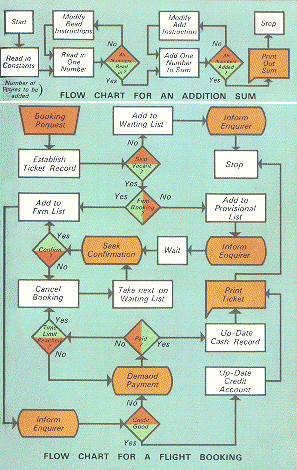
 |
Programming |
Programming |
|
 |
A set of instructions given to a computer is known as a program.
The first step in preparing such a program is to draw a flow chart, two examples
of which are shown opposite. This is built up from a number of connected
boxes, the label attached to each box showing the job or calculation which
is to be done at each step. One very important type of box is the decision
box, in which a question is asked. The only answers allowed to the computer
are 'yes or 'no' and although this may seem too simple to be of use in a
complicated problem, remember that a computer can ask nearly half a million
questions a second!
Transferring the job of each box into number form (machine code) is very laborious, and the programmer is helped in this task by an intermediate language (high level language) which is then translated by a master program (the compiler) into machine code. There are many high level languages in use, the most common being COBOL (COmmon Business Orientated Language), BASIC (Beginners All-purpose Symbolic Instruction Code), PLI1 (Programming Language One), FORTRAN (FORmula TRANslation), and RPG (Report Program Generator). Programming in machine code is a job for a highly trained person, whereas programming in a high level language is something many people can do provided they are given time to learn the rules that must be followed. |
Reproduced from "How it Works" Ladybird Series